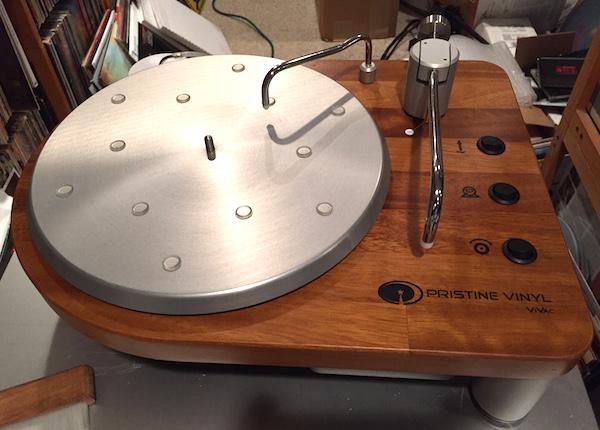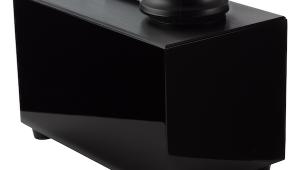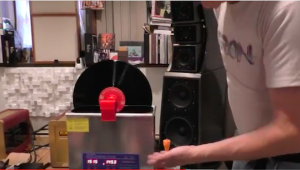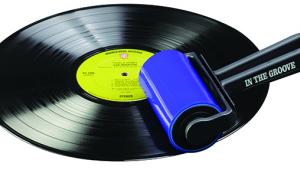I'm hoping you will do a full review of the Ultra Sonic V8. My impressions, based on all of your reviews, is that ultra sonic cleaning is superior to all other cleaning methods. The V8 is similar in price to this more elegant looking cleaner...but which cleans vinyl better?
The Pristine Vinyl ViVac RCS2 “Thread Type” Record Cleaning Machine
This “thread” type record cleaning machine is also compact and easy to use once you get the “hang” of it. It’s also superbly built and logistically, equally well thought out.
“Thread” type machines (the others being from Keith Monks (the inventor of this cleaning method) and Loricraft, use a vacuum and an arm that moves across the record surface, riding on a thread separating the record from a vacuum nozzle. The thread provides the necessary distance to avoid the suction from adhering the nozzle to the record surface.
The advantage of this system to the more typical “velvet lip” type vacuum machine is that with every record cleaned, a clean length of spooled thread contacts the record. Unless they are kept scrupulously clean, velvet lipped cleaners can spread contaminants onto records, which is one reason really dirty records should be pre-cleaned before being vacuum cleaned with “velvet lip” type machines and even then proper lip hygiene is critical. While pre-cleaning is less critical with thread type machines because of the fresh surface with each record cleaned, it's still recommended.
The disadvantages of the thread type machines is that they are much slower and because the platter spins far faster, if you’re not careful when you apply fluid, it can fly off the record and wet your pants, or the machine, or worse, migrate to the other side of the record.
The point is, you have to be careful using every type of machine, though the Audio Desk and KLAUDIO cavitation based machines are somewhat more forgiving, though naysayers would say you're cleaning records using dirty fluid after the first record.
Rather than go through the process of using this machine here, I suggest you watch the video. As for the results, based on my experience, in terms of record cleaning, the Pristine Vinyl ViVac works as well as the other brands. However, its build quality and application of the technology set it apart (there’s also a less costly model that doesn’t apply fluid with a built-in pump, which the reviewed sample includes).
I like that the spool of thread is hidden under the platter. That keeps stray fluid from contaminating the entire spool, which can be an issue with some other machines. The dirty fluid tank is also located underneath the platter, which helps keep the unit’s footprint small. In addition the thread path is also under the wooden platform, which keeps it out of the way while you’re cleaning records.
When you actuate the fluid dispenser, it automatically moves across the record surface, which is convenient, but you need to be ready with a finger on the pump button (as you’ll see in the video). Once you’ve spread the fluid, you just move the thread bearing arm to the label area of the record and the vacuum system automatically starts as does the movement of the arm back towards the record’s outside edge. Once the arm gets there, it automatically stops and the vacuum shuts down. It could not be easier.
My one issue with the ViVac is the relatively low torque motor. It will stop spinning if you bear down even slightly on the platter, though really it’s not a good idea to apply too much pressure to the record surface because you’re more likely to smoosh dirt in rather than loosen it up.
The supplied fluid is alcohol-free and features a vegetable-based fluid made using distilled water plus a vegetable-based surfactant. Of course you can use whichever fluid you prefer. A moderately stiff bristled nylon brush is included but again you can use your choice of applicator/brush. I like the rubber I-beam type with large microfiber surface created by Disc Doctor and copied by Mobile Fidelity.
Overall, I found the Pristine Vinyl ViVac RCS to be a beautifully made, easy to use and cleverly thought out application of the thread-type record cleaning machine. It’s also the best looking and it’s quite compact. It also comes with a dust cover.
Because of the current strength of the U.S. dollar, the U.K. built ViVac with built in applicator pump mechanism currently costs $2610. The manufacturer will be exhibiting at this November’s Rocky Mountain Audio Festival in Denver, Colorado and plans “satellite” American distribution.
This is one record cleaning machine you might get away with leaving in the living room!
Manufacturer's Comment:
"We have added a clutch to the platter to stop it if too much pressure is applied to the record. The reason for this is that a brush won't get down into the grooves so the ViVac machine relies on the liquid breaking up the contaminants and dirt before they are removed by the vacuum.
We were worried that people would scrub the record which could lead to damage so the torque of the platter has been set to ensure not too much pressure can be applied.
As the platter is 'clutched' we can use a stiffer brush which is only used to spread the liquid evenly over the record's surface."
- Log in or register to post comments


it brings the point nozzle machine into a more reasonable price point. (I think Monks is also introducing a cheaper unit with an acrylic cabinet). I like the combination of point nozzle and ultrasonic. I'm often faced with old, used pressings, and combining cleaning methods seems to be synergistic. I've also been exploring a DIY type ultrasonic to have certain features that the commercial machines lack. But, by the time I'd get the components together to do this, it would probably exceed the cost of the commercial machines. Ah, records, can't live without 'em, but.....
best,
bill hart

I would like to know the company that makes that super-solution. I like to try it on my RCM.

I also really used to like Torumat. I don't see a dealer for it. Any idea?

it certainly looks nice
much better than my Loricraft - Keith Monks knock off
hidden off in a spare bedroom
My KLaudio unit looks pretty sexy with the black silencer on top
Cavitation naysayers haven't looked at an lp when it comes off an ultrasonic,or spent much time listening to the micro detail of an ultrasonically cleaned record, or looked at the slight change in the color of the water as you change it out after 100 records were cleaned
This looks a nice execution of the string cleaning.

is the wood surface "splash proof"?

I just had to point out that with all of the care you take regarding cleaning and explaining the best way to do so, you put your oily fingers all over the platter and the standoffs on the machine before you cleaned the lp. Sorry.
I noticed how warped the EP was when you cleaned it and how flat it was in the YouTube video. You apparently had flattened it prior to making the video. This brings me to my main point: I wish you would be a voice for us ( especially with the ever increasing prices) all regarding the quality of vinyl we buy and pointing out any defects or damage you notice when reviewing a lp. I believe it may make a difference.
I hope you'll let us know where that EP can be found when you review it. Right now, I'm coming up empty. Thanks.

The Odyssey was a German mad, thread-type RCM, the same approach as the Keith Monks and LoriCraft machines. I've had one for several years now and love it. Sad to hear recently the company is no longer around.

Hello. Essays, as one of the types of creative works, are also of different types. In particular, if you need to write a business letter essay, I would like to advise you to read the article on how to write a letter essay https://domyessay.com/blog/business-letter-essay . The service's specialists have given a lot of useful tips on writing this type of essay. You will learn about the structure, template, style and font size. Therefore, I am sure that this article will help you.



















































